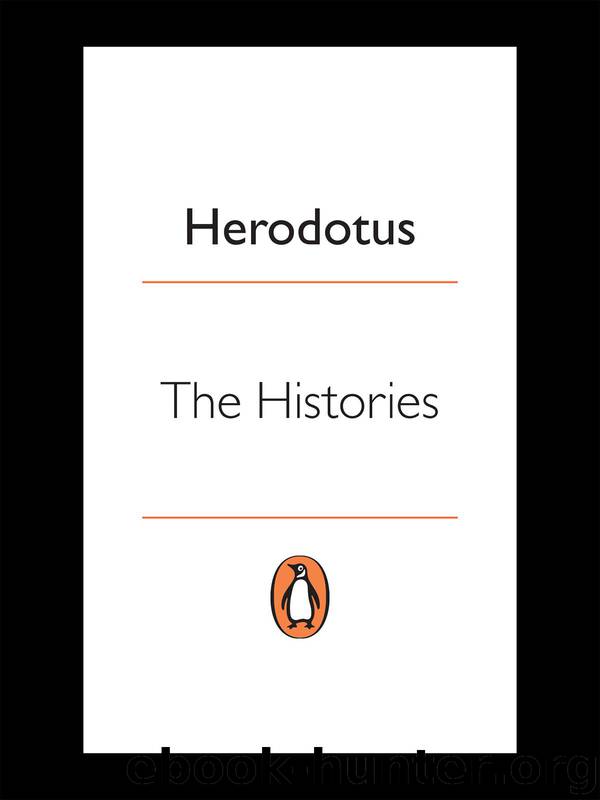The Histories (Penguin Classics) by Herodotus

Author:Herodotus
Language: eng
Format: azw3
ISBN: 9780141917153
Publisher: Penguin Books Ltd
Published: 2003-01-29T16:00:00+00:00
At dawn next morning he was seen communicating his dream to the interpreters; but later he put it out of his mind and took part in the procession, during which he was killed.
The Gephyraei, to whom the two men who killed Hipparchus [57] belonged, came, by their own account, originally from Eretria; but I have myself looked into the matter and find that they were really Phoenicians, descendants of those who came with Cadmus to what is now Boeotia, where they were allotted the district of Tanagra to make their homes in. After the expulsion of the Cadmeans by the Argives, the Gephyraei were expelled by the Boeotians and took refuge in Athens, where they were received into the community on certain stated terms, which excluded them from a few privileges not worth mentioning here. The Phoenicians who came with Cadmus – amongst whom were [58] the Gephyraei – introduced into Greece, after their settlement in the country, a number of accomplishments, of which the most important was writing, an art till then, I think, unknown to the Greeks.29 At first they used the same characters as all the other Phoenicians, but as time went on, and they changed their language, they also changed the shape of their letters. At that period most of the Greeks in the neighbourhood were Ionians; they were taught these letters by the Phoenicians and adopted them, with a few alterations, for their own use, continuing to refer to them as the Phoenician characters – as was only right, as the Phoenicians had introduced them. The Ionians also call paper ‘skins’ – a survival from long ago when paper was hard to get, and they did actually use goat and sheep skins to write on. Indeed, even today many foreign peoples use this material. In the temple of Ismenian Apollo at Thebes in Boeotia I have [59] myself seen tripods with inscriptions cut on them in Cadmean characters – most of them not very different from the Ionian. There were three of these tripods; one was inscribed: ‘Amphityron dedicated me from the spoils of the Teleboae’, and would date from about the time of Laius, son of Labdacus, grandson of Polydorus and great-grandson of Cadmus. Another had an [60] inscription of two hexameter verses:
Scaeus the boxer, victorious in the contest,
Gave me to Apollo, the striker from afar, a lovely offering.
Download
This site does not store any files on its server. We only index and link to content provided by other sites. Please contact the content providers to delete copyright contents if any and email us, we'll remove relevant links or contents immediately.
| Africa | Americas |
| Arctic & Antarctica | Asia |
| Australia & Oceania | Europe |
| Middle East | Russia |
| United States | World |
| Ancient Civilizations | Military |
| Historical Study & Educational Resources |
Mythos (2019 Re-Issue) by Stephen Fry(1199)
Alexander the Great by Robin Lane Fox(1182)
Antigone Rising: The Subversive Power of the Ancient Myths by Helen Morales(949)
On Sparta (Penguin Classics) by Plutarch(929)
The Classical World: An Epic History From Homer to Hadrian by Robin Lane Fox(890)
The Last Days of Socrates by Plato & Christopher Rowe & Plato(889)
Persian Fire by Tom Holland(833)
Cicero by Anthony Everitt(785)
The Athenian Constitution (Classics) by Aristotle(773)
The Greek World(702)
Antigone Rising by Helen Morales(663)
The Eudemian Ethics (Oxford World's Classics) by Kenny Anthony(648)
The Riddle of the Labyrinth(635)
The Story of the Greeks (Yesterday's Classics) by Guerber H. A(623)
Lords of the Sea: The Epic Story of the Athenian Navy and the Birth of Democracy by John R. Hale(620)
Guide to Greece by Pausanias(611)
The End of the Bronze Age by Robert Drews;(597)
The Homeric Hymns (Penguin Classics) by Homer(579)
Astrology and Religion Among the Greeks and Romans by Cumont Franz(576)
